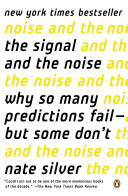Autism as a Self-Fulfilling Prophecy
Diseases and other medical conditions can also have this self-fulfilling property. When medical conditions are widely discussed in the media, people are more likely to identify their symptoms, and doctors are more likely to diagnose (or misdiagnose) them. The best-known case of this in recent years is autism. If you compare the number of children who are diagnosed as autistic64 to the frequency with which the term autism has been used in American newspapers,65 you’ll find that there is an almost perfect one-to-one correspondence (figure 7-4), with both having increased markedly in recent years. Autism, while not properly thought of as a disease, presents parallels to something like the flu.
“It’s a fascinating phenomenon that we’ve seen. In diseases that have no causal mechanism, news events precipitate increased reporting,” I was told by Dr. Alex Ozonoff of the Harvard School for Public Health. Ozonoff received his training in pure mathematics and is conversant in many data-driven fields, but now concentrates on applying rigorous statistical analysis to the flu and other infectious diseases. “What we find again and again and again is that the more a particular condition is on people’s minds and the more it’s a current topic of discussion, the closer the reporting gets to 100 percent.”
Notes:
As the illness gets more attention, more people are diagnosed with it.
Folksonomies: mental illness prediction diagnosis disease
Taxonomies:
/health and fitness/disease/autism and pdd (0.543719)
/health and fitness/disease (0.440862)
/health and fitness/disorders (0.240429)
Keywords:
medical conditions (0.942622 (negative:-0.894556)), perfect one-to-one correspondence (0.912386 (positive:0.558567)), rigorous statistical analysis (0.856922 (negative:-0.559648)), Dr. Alex Ozonoff (0.842466 (neutral:0.000000)), term autism (0.719772 (positive:0.558567)), best-known case (0.668784 (positive:0.455446)), Self-Fulfilling Prophecy (0.662447 (negative:-0.701222)), fascinating phenomenon (0.652319 (positive:0.743095)), self-fulfilling property (0.630035 (negative:-0.894556)), causal mechanism (0.628972 (negative:-0.753056)), data-driven fields (0.622985 (positive:0.329623)), American newspapers,65 (0.620014 (positive:0.558567)), people’s minds (0.602498 (neutral:0.000000)), news events (0.601260 (negative:-0.528438)), particular condition (0.601002 (neutral:0.000000)), Harvard School (0.600355 (neutral:0.000000)), Public Health (0.598701 (neutral:0.000000)), current topic (0.597511 (neutral:0.000000)), pure mathematics (0.593758 (positive:0.329623)), infectious diseases (0.589192 (negative:-0.559648)), flu (0.457744 (negative:-0.313621)), conversant (0.390417 (positive:0.329623)), parallels (0.375858 (positive:0.246027)), percent (0.367478 (neutral:0.000000)), attention (0.365953 (negative:-0.701222)), illness (0.363990 (negative:-0.701222)), doctors (0.357005 (negative:-0.560237)), media (0.356060 (neutral:0.000000)), symptoms (0.355846 (negative:-0.570827)), misdiagnose (0.355585 (neutral:0.000000))
Entities:
Diseases:HealthCondition (0.893245 (negative:-0.671952)), flu:HealthCondition (0.650384 (negative:-0.156811)), Dr. Alex Ozonoff:Person (0.599995 (positive:0.329623)), Harvard School for Public Health:Organization (0.476639 (neutral:0.000000)), 100 percent:Quantity (0.476639 (neutral:0.000000))
Concepts:
Infectious disease (0.979258): dbpedia | freebase
Epidemiology (0.829781): dbpedia | freebase | opencyc
Disease (0.711945): dbpedia | freebase | opencyc
Medicine (0.709386): dbpedia | freebase
Infection (0.626867): dbpedia | freebase | opencyc
Medical terms (0.549200): dbpedia
Causality (0.533191): dbpedia | freebase
Statistics (0.511912): dbpedia | freebase | opencyc





